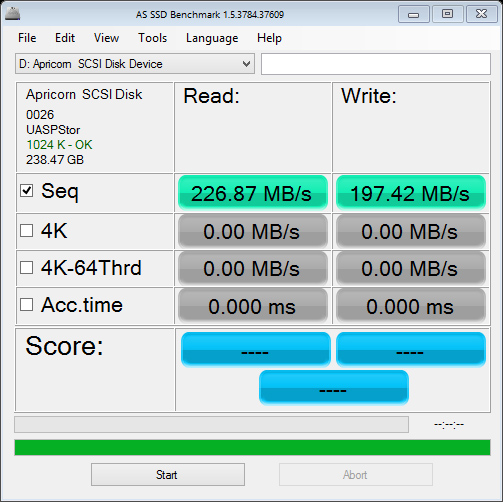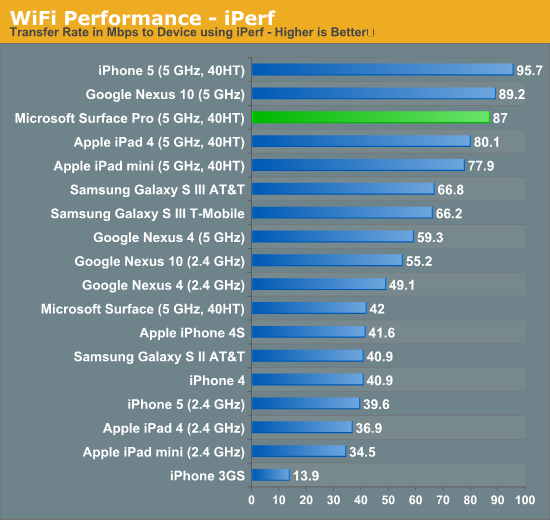Microsoft Surface Pro Review
by Anand Lal Shimpi on February 5, 2013 9:00 PM ESTFans and Thermals
While Surface RT was passively cooled, Surface Pro features two integrated fans to cool the 17W Core i5-3317U. For most light use cases, those two fans will remain spun down and you can’t hear them. Do any sort of serious multitasking or start using Surface Pro as a real PC instead of a tablet and you’ll quickly hear them spin up. Fan noise is audible but not annoying - it’s very similar to the sound you’d hear out of any ultraportable with a couple of tiny fans spinning up.
In landscape mode with the Type Cover attached, Surface Pro draws in cool air from the sides and exhausts it out of the top of the device. Rotate the device into portrait mode and the fans will switch directions, drawing in cool air from the long edge and exhausting it out of the short edges. The fan direction switch is triggered in tandem with display rotation, so as soon as you see your display rotate you’ll hear the fans change direction.
The two fans do a good job keeping the CPU cool (I saw typical CPU core temperatures between 50C - 60C), but Surface Pro does get warm. I measured a max surface temperature of 41.8C while running 3DMark 11. That’s towards the top of the unit, around where the Core i5 CPU is located. On the edges I measured a max surface temperature of 36.5C. There’s no getting around the fact that Surface Pro gets warm, noticeably more so than the 4th generation iPad. It never gets uncomfortably hot however.

Despite being a tablet, the Core i5-3317U had no issues hitting its max turbo frequency of 2.6GHz. I even saw 2.75GHz for a very short period of time (remember, Intel’s Turbo Boost can exceed max TDP until the silicon gets up to temperature).
Storage and USB 3.0
Surface Pro ships with a micro SDXC slot along the edge of the device. Courtesy of Intel’s HM77 chipset, you also get a full blown 6Gbps SSD and a single USB 3.0 port - both significant upgrades over Surface RT. In my 128GB review sample, Surface Pro features a Micron C400 SSD. Microsoft is sourcing from multiple SSD vendors and claims to be shipping with optimized firmware, but I don’t know what other vendors are in the mix. Update: It looks like the C400 SSD is an mSATA drive, likely similar to the one we reviewed here a while back.

To put this in perspective, the C400 is in the same class of storage device that’s used in Apple’s MacBook Air. Although some ARM based SoCs feature SATA interfaces, pretty much all of them are paired with eMMC based NAND storage solutions that are horribly slow. The fastest sequential transfer rates I’ve managed on the 4th generation iPad are typically on the 20 - 30MB/s range, whereas the C400 in the Surface Pro is good for over 400MB/s in reads and just under 200MB/s in writes.

There’s been a lot of debate over the amount of free space available on Windows RT/8 tablets fresh out of the box. My 128GB review sample was partitioned down to 110GB with roughly 8GB used for the recovery partition. Of that 110GB, 89.5GB was free space that remained. I don’t really view this as false advertising by Microsoft (both Macs and PCs have been sold like this for decades), but you do need to know what you’re getting into here. Given the already high price of these systems and the relatively small price differential between a 64GB Surface Pro and a 128GB model, I’d recommend going for the latter. Microsoft claims something like 29GB of free space remains on the 64GB model - enough for some apps and data, but keep in mind like all solid state storage you don’t want to completely fill up your drive either (this is also true for ARM based tablets like the iPad).
USB 3.0 is equally as impressive on Surface Pro. Using a simple USB 3.0 to SATA adapter I could easily read and write at around 200MB/s. Compare this to the ~20MB/s you get on most ARM based tablets and it’s obvious that this Surface deserves its Pro moniker.

Ultimately Surface Pro’s storage subsystem is a big part of what separates it from the current crop of ARM based tablets. While it’s possible to run productivity workloads on many tablets these days, there’s truly very little that separates what you can do on Surface Pro with what what you can do on a conventional PC.
WiFi Performance
Similar to Surface RT, Surface Pro uses a 2x2 802.11n WiFi controller from Marvell. I believe this is likely the same Marvell Avastar 88W8797 WiFi solution, but connected over USB instead of SDIO.
WiFi performance is appreciably better than on Surface RT, connected to a 5GHz 802.11n network I was able to pull a maximum of 87Mbps compared to 42Mbps on Surface RT. This is competitive with what I’ve seen on other high-end tablets based on ARM architectures, although lower than what I’ve gotten out of a MacBook Air.

WiFi range is subjectively really good on Surface Pro and a lot better than most ARM based tablets I’ve played with. I ran an iperf test on an iPad 4 and Surface Pro around 100 feet away from an AP through several walls and saw roughly an order of magnitude better performance out of the Surface Pro (8 - 10Mbps vs. 0.95 Mbps).
While peak WiFi performance out of Surface Pro is similar to a high-end tablet, worst case performance is more like a good notebook. Overall I’m pleased with the wireless stack on Surface Pro.










228 Comments
View All Comments
Morgifier - Tuesday, February 5, 2013 - link
The design of the (as yet unreleased) Asus Transformer Book seems preferable, with the external keyboard providing rigidity, additional battery life and extra storage. I wonder if Microsoft have considered this?Although I'm yet to use Windows 8, I do like the idea of device convergence...
cmikeh2 - Tuesday, February 5, 2013 - link
I totally agree with you that Transformer Book seems a lot nicer (especially with the bundled dock) but they're sort of in two different product classes since the Transformer Book (1.9 kg) is about twice the weight of the Surface Pro.althaz - Wednesday, February 6, 2013 - link
If you want something that is three-in-one (desktop replacement, tablet, notebook replacement), the Asus or the Samsung ATIV with similar specs to the Surface Pro are a much better choice.For me though, I never, ever want to type with this thing in my lap. I want to watch videos or play games (mostly Football Manager) while I'm on the train. I want to hook it up to a bunch of XBox controllers and a TV for playing on the multitude of old-school emulator with my buddies, I want to plug a keyboard and mouse into it to play starcraft at my mate's place and my wife wants to surf the internet and play angry birds at home.
I have a desktop at home and at work, this is for everything else which means I don't need the dock (the touch cover would be handy for typing things up when I'm say, on an aeroplane or on a holiday though), or the added weight and price it includes.
I can't wait to get one of these!
jeffkibuule - Wednesday, February 6, 2013 - link
The Samsung ATIV Smart PC Pro has typical Samsung tablet build quality. I wouldn't touch that thing with a 10" pole. Perhaps their Ultrabooks are of better build quality, but the ATIV isn't it.LetsGo - Wednesday, February 6, 2013 - link
Nothing wrong with my Samsung 7.7 Tabs build quality.When they update there 8" Note to a Octo-core I will get one, a tablet should be light therefore being made out of plastic is good design.
B3an - Wednesday, February 6, 2013 - link
Does anyone know when the Transformer Book is actually going to come out? Been waiting for this for ages. Asus are taking the piss. Might just go for Surface Pro.PubFiction - Wednesday, February 6, 2013 - link
IMO, the whole point of surface was to bring to market something the other OEMs were not doing. Transformer is a great form factor, but so what ASUS whom is a big MS partner is already making it why would MS step in and build another transformer when one already exists? The draw to surface is the light ultra thin keyboard. But are you going to get the best typing experience from that? No, of course not, will it be better than typeing with the softboard? Yes.Surface brings one major thing to the table, the ultra thin tablet / laptop combo device. It can do everything, but of course in certain situations it will not be the best device. But compared to the price of other ultra books it is very good. It sports a good CPU, touch screen, digitizer etc. Ultimately you see an over abundance of negative posts which are simply stupid because they compare apples to oranges. People compare this to a mac book air, which has no, touch screen, no tablet mode, and no digitizer. Well duh if all you want is an ultra book then this isnt for you but its ridiculous to even bother comparing a device which is so different and lacks so many features.
What we really need is for the OEMs to fill in the gaps in product lines not try to compete with each other in products that already exists. What we are still missing is a gaming level convertible. Alienware, samsung series 7 gamer, clevo et al. Lenovo has built alot of combinations of tablets and laptops but now we need something sporting at least a 660M that can flip into a tablet and has a built in digitizer.
My biggest complaint with this device has to be the lack of slot for the digitizer pen, the big strength of surface was the compact all in one nature where the keyboard is not a clumsy accessory but an integral part of the device. The pen should have followed that lead.
PubFiction - Wednesday, February 6, 2013 - link
Of course the other issue is non remvable battery which means if you are dropping $900+ on this it wont last more than 2 years before the battery craps out like all sealed batteries.Netscorer - Wednesday, February 6, 2013 - link
most ultrabooks have non-accessible battery. Not sure what your point is. If it is important to you to be able to access memory, storage, battery and other internals, buy a regular laptop, not a tablet.And realistically, batteries last more then two years. The performance may become degraded after some time but I've had batteries lasting 3-5 years on all my devices and by the time they are truly dead, the device is typically obsolete and needs replacement, anyway.
spencer.p - Wednesday, February 6, 2013 - link
That's true.I would recommend perhaps getting a Surface Complete warranty for it (if you get it from the Microsoft Store). $99 for two years of accidental, too.